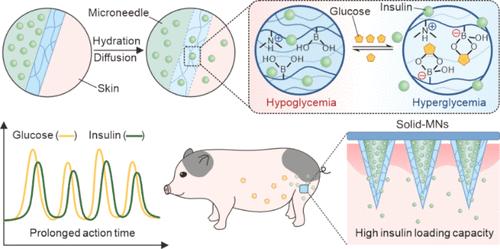Glucose-Responsive Microneedle Patch with High Insulin Loading Capacity for Prolonged Glycemic Control in Mice and Minipigs
IF 15.8
1区 材料科学
Q1 CHEMISTRY, MULTIDISCIPLINARY
引用次数: 0
Abstract
Transdermal microneedle-mediated glucose-responsive insulin delivery systems can modulate insulin release based on fluctuations in blood glucose levels, thus maintaining normoglycemia effectively in a continuous, convenient, and minimally invasive manner. However, conventional microneedles are limited by the low drug loading capacity, making it challenging to be applied on human skin at a reasonable size for a lasting glucose-controlling effect, thus hindering their clinical translation. Here, we design a microneedle patch with a solid insulin powder core to achieve a high loading capacity of insulin (>70 wt %) as well as a glucose-sensitive polymeric shell to realize glucose-responsive insulin release. Once exposed to hyperglycemia, the formation of negatively charged glucose–boronate complexes increases the charge density of the shell matrix, leading to swelling of the shell and accelerating insulin release from the core. We have demonstrated that this glucose-responsive microneedle patch could achieve long-term regulation of blood glucose levels in both type 1 diabetic mice and minipigs (up to 48 h with patches of ∼3.5 cm2 for minipigs >25 kg).

具有高胰岛素负荷能力的葡萄糖反应微针贴片,可延长小鼠和迷你猪的血糖控制时间
透皮微针介导的葡萄糖反应胰岛素给药系统可根据血糖水平的波动调节胰岛素的释放,从而以连续、方便和微创的方式有效维持正常血糖。然而,传统的微针受限于载药量低,难以以合理的尺寸应用于人体皮肤以达到持久的血糖控制效果,从而阻碍了其临床转化。在这里,我们设计了一种以固体胰岛素粉末为核心的微针贴片,实现了胰岛素的高负载能力(70 wt %),同时还设计了葡萄糖敏感聚合物外壳,实现了葡萄糖反应性胰岛素释放。一旦暴露在高血糖环境中,带负电荷的葡萄糖-硼酸复合物的形成会增加外壳基质的电荷密度,导致外壳膨胀,加速胰岛素从核心释放。我们已经证明,这种葡萄糖反应微针贴片可以长期调节 1 型糖尿病小鼠和迷你猪的血糖水平(对于体重 25 千克的迷你猪,贴片面积为 3.5 平方厘米,最长可达 48 小时)。
本文章由计算机程序翻译,如有差异,请以英文原文为准。
求助全文
约1分钟内获得全文
求助全文
来源期刊

ACS Nano
工程技术-材料科学:综合
CiteScore
26.00
自引率
4.10%
发文量
1627
审稿时长
1.7 months
期刊介绍:
ACS Nano, published monthly, serves as an international forum for comprehensive articles on nanoscience and nanotechnology research at the intersections of chemistry, biology, materials science, physics, and engineering. The journal fosters communication among scientists in these communities, facilitating collaboration, new research opportunities, and advancements through discoveries. ACS Nano covers synthesis, assembly, characterization, theory, and simulation of nanostructures, nanobiotechnology, nanofabrication, methods and tools for nanoscience and nanotechnology, and self- and directed-assembly. Alongside original research articles, it offers thorough reviews, perspectives on cutting-edge research, and discussions envisioning the future of nanoscience and nanotechnology.
文献相关原料
公司名称
产品信息
麦克林
STZ
麦克林
NVP
阿拉丁
2-Hydroxy-4′-(2-hydroxyethoxy)-2-methylpropiophenone (Irgacure 2959)
 求助内容:
求助内容: 应助结果提醒方式:
应助结果提醒方式:


